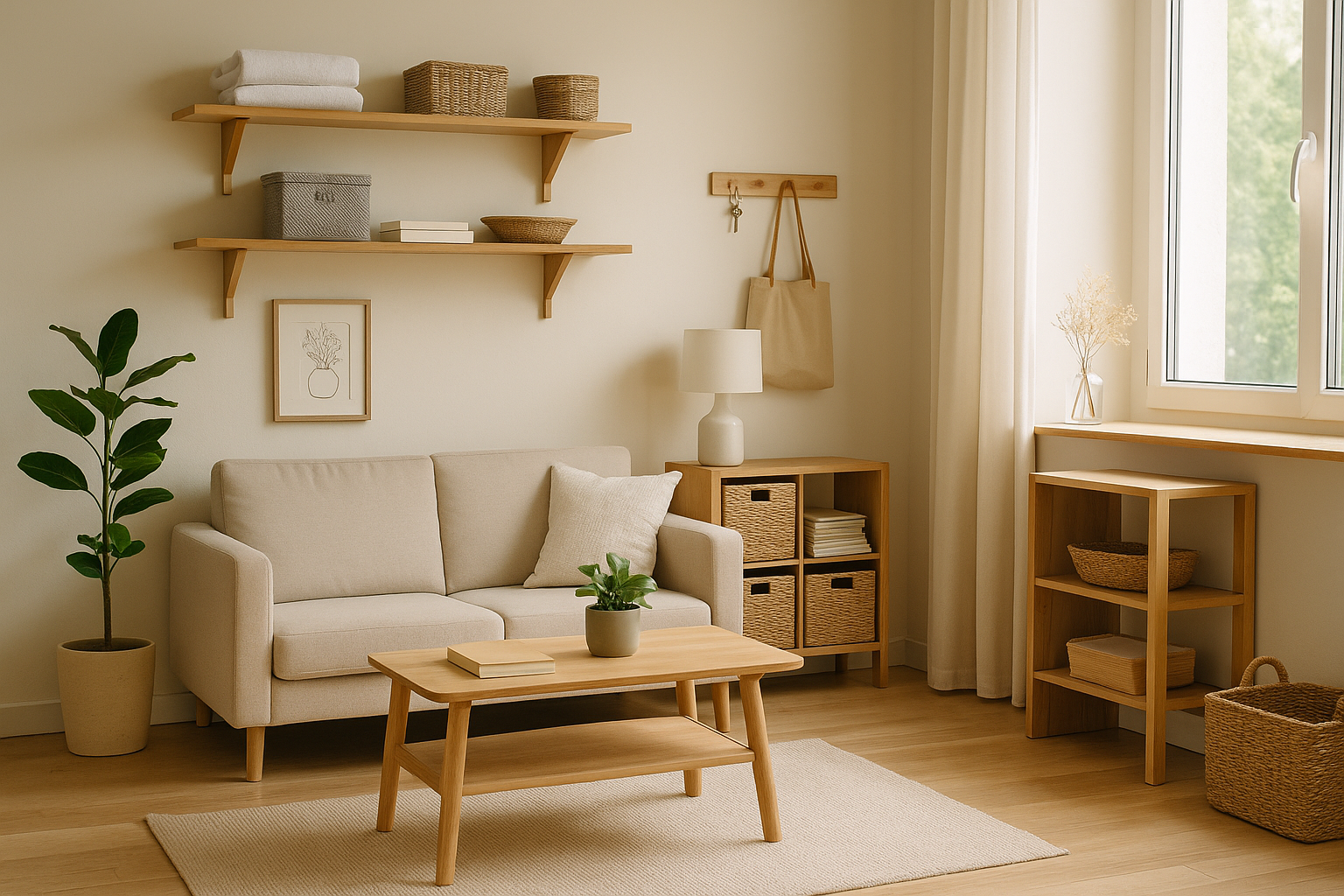Small apartments can be cozy, affordable, and efficient—but without a good organization system, they can quickly become chaotic. With limited square footage, every item needs a place, and clutter can pile up fast if you’re not intentional.
Whether you live in a studio, a one-bedroom, or a compact shared space, these expert tips will help you maintain a neat, functional home that feels spacious and stress-free—all the time, not just after a deep clean.
1. Embrace the “One In, One Out” Rule
One of the most effective ways to stay organized is to limit what comes in.
How it works:
- For every new item you bring into your apartment (a shirt, dish, book, etc.), remove or donate one existing item.
- Keeps clutter from building up
- Forces you to make thoughtful purchases
This rule is especially powerful in small homes where every drawer, shelf, and closet is prime real estate.
2. Declutter by Zone, Not Room
Decluttering an entire room at once can be overwhelming. Instead, break it down into micro-zones.
Try:
- One kitchen drawer
- One shelf in your closet
- One corner of your desk
Aim to complete one zone per day or per week. This slow-but-steady approach is easier to maintain and leads to long-term results.
3. Use Furniture with Built-In Storage
Multifunctional furniture is a game-changer in compact living.
Best options:
- Storage ottomans: Perfect for blankets, remotes, or off-season clothing
- Beds with drawers or under-bed containers
- Coffee tables with shelving
- Sofas with hidden compartments
- Desks with drawers or shelves
Every piece of furniture should pull double duty when space is tight.
4. Keep Surfaces Clear
A clean surface instantly makes a room feel organized, even if everything else is still a work in progress.
Clear these regularly:
- Dining or coffee tables
- Kitchen counters
- Bathroom sink area
- Nightstands
Use trays, boxes, or bowls to group small items and keep visual clutter to a minimum.
5. Maximize Vertical Space
Don’t just think horizontally—look up!
Tips:
- Install shelves above doors, windows, or desks
- Use tall bookcases instead of short ones
- Add hooks or pegboards for bags, coats, and accessories
- Store seasonal items on high closet shelves
Vertical storage frees up floor space and creates a cleaner layout.
6. Use Clear and Labeled Containers
Transparent bins make it easy to see what you have, while labels ensure everything returns to its rightful place.
Great for:
- Pantry goods
- Bathroom toiletries
- Craft or office supplies
- Closet accessories (scarves, belts, shoes)
Use consistent containers for a streamlined, tidy look.
7. Practice the 5-Minute Daily Reset
At the end of each day, set a timer and do a 5-minute tidy-up.
What to focus on:
- Dishes in the sink
- Clothes on chairs or floors
- Trash or recycling
- Items that migrated from one room to another
Small daily resets prevent mess from piling up and becoming overwhelming.
8. Keep a Donation Box Handy
Always have a box or bag in a closet designated for items you no longer use.
When you find something that doesn’t serve you anymore, toss it in. Once it’s full, drop it off at a local donation center. This keeps your home in a constant state of renewal.
9. Create Drop Zones for Essentials
Avoid the daily “where are my keys?” panic by setting up intentional drop zones near the entrance.
Include:
- A small table or wall shelf
- A bowl for keys and coins
- A hook for bags, masks, or umbrellas
- A small drawer or basket for mail
Train yourself (and others in your home) to always use these zones.
10. Avoid Over-Organizing
Not everything needs its own bin or color-coded system. In fact, over-organization can make it harder to maintain.
Focus on simple, intuitive solutions:
- One drawer for all tools
- One bin for miscellaneous office supplies
- One tray for electronics and chargers
Keep systems flexible so they’re easy to follow on a daily basis.
11. Rotate Decorative Items Seasonally
Too many decor items can clutter surfaces quickly. Keep your space feeling fresh by rotating items every few months.
Example:
- Store away heavy vases or cozy throws in summer
- Swap out pillow covers or art prints seasonally
- Keep only a few decorative pieces out at a time
This keeps your space dynamic and prevents it from feeling overcrowded.
12. Digitize Paper Whenever Possible
Paper piles up fast—bills, notes, manuals, receipts. Go digital to reduce clutter.
Ideas:
- Scan documents with your phone
- Sign up for paperless billing
- Store instruction manuals online (many are already on manufacturer websites)
- Use apps for notes, checklists, and reminders
Less paper = less mess = more space.
13. Store Items Where You Use Them
This sounds obvious, but it’s often overlooked.
Examples:
- Keep cleaning supplies in each area they’re needed (kitchen, bathroom)
- Store your yoga mat where you actually do yoga
- Place spare chargers in the rooms you use your devices most
Convenient storage makes organization easier to maintain long-term.
14. Create Systems for Things You Use Every Day
Think about what clutters your space most often—and create a system to manage it.
Solutions:
- A basket for TV remotes
- Hooks for reusable shopping bags
- A caddy for bathroom products used daily
- A mini charging station for electronics
Once everything has a place, it’s much easier to keep it there.
15. Celebrate Progress, Not Perfection
No apartment will be perfectly tidy 100% of the time. The goal is not perfection, but sustainability. The more manageable your systems are, the more likely you are to maintain them.
Celebrate the small wins:
- A clean desk
- An organized pantry shelf
- An empty laundry basket
These steps build momentum and make organization a habit.
Keeping your apartment organized isn’t about spending hours cleaning or investing in complicated systems. It’s about being intentional, using space wisely, and adopting habits that support daily order.
By incorporating small, consistent changes—like using vertical storage, keeping surfaces clear, and decluttering zone by zone—you can create a calm, efficient, and welcoming home you’ll love to live in every day.

